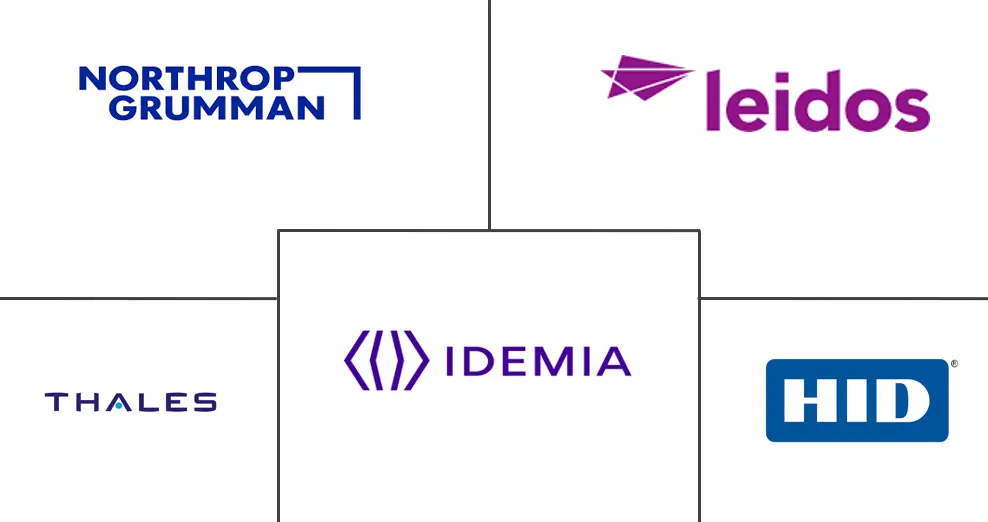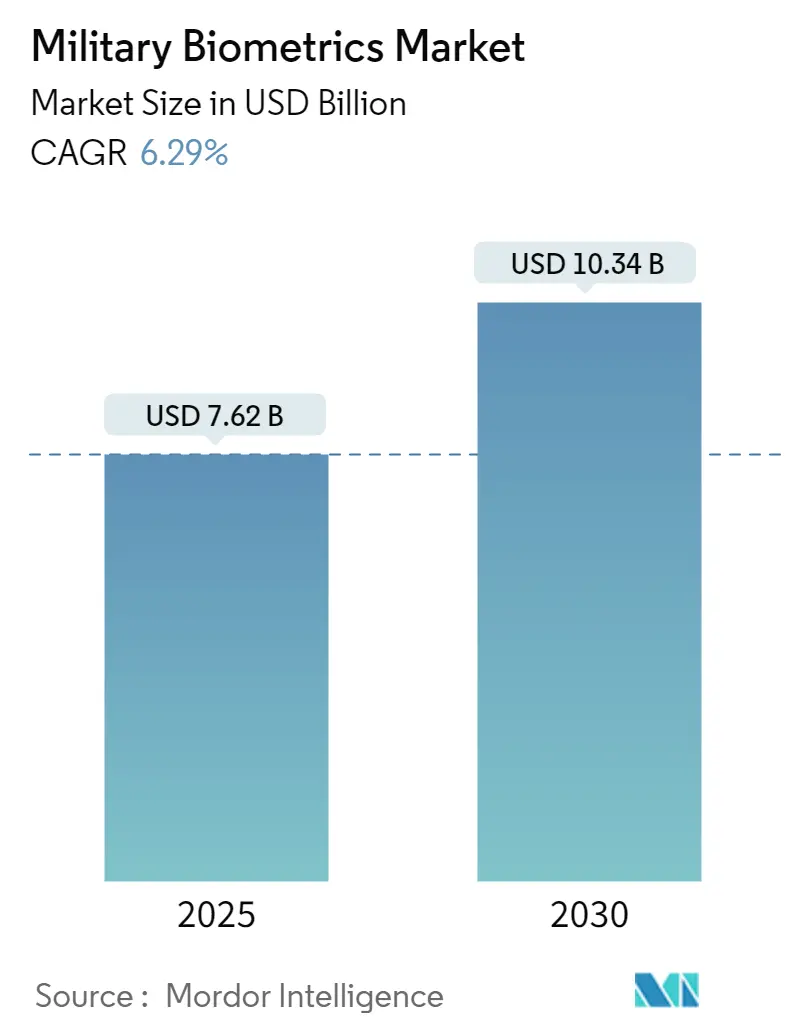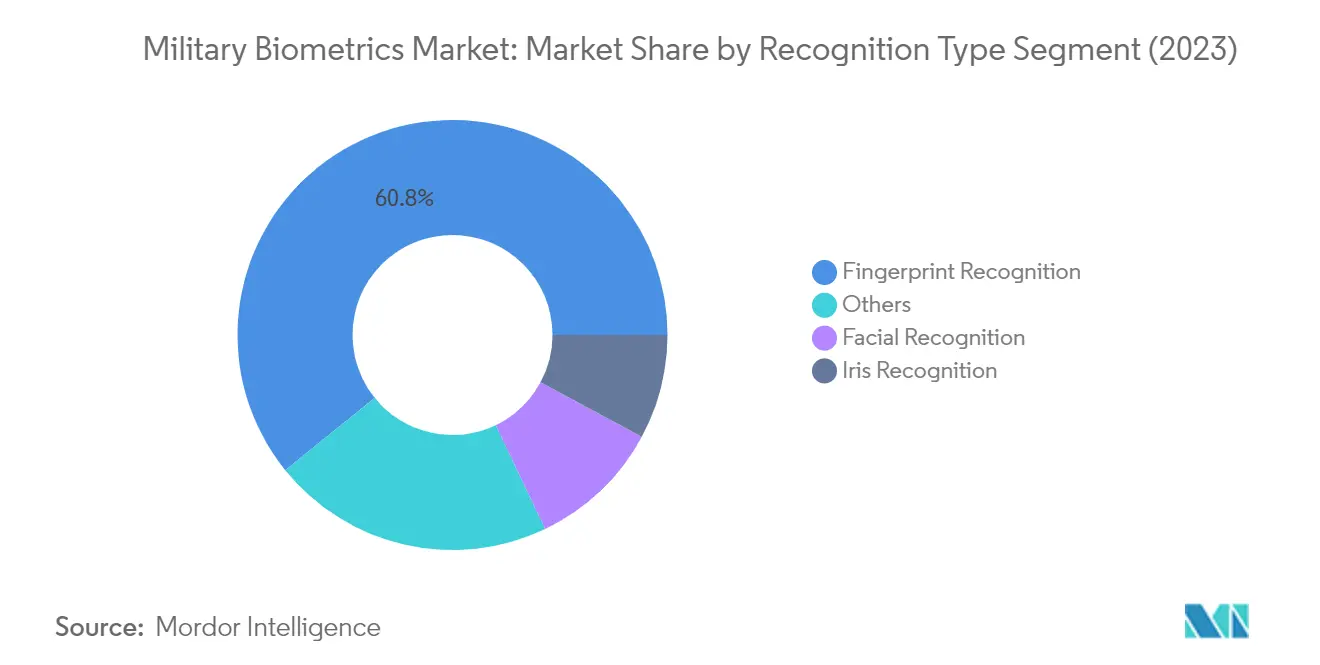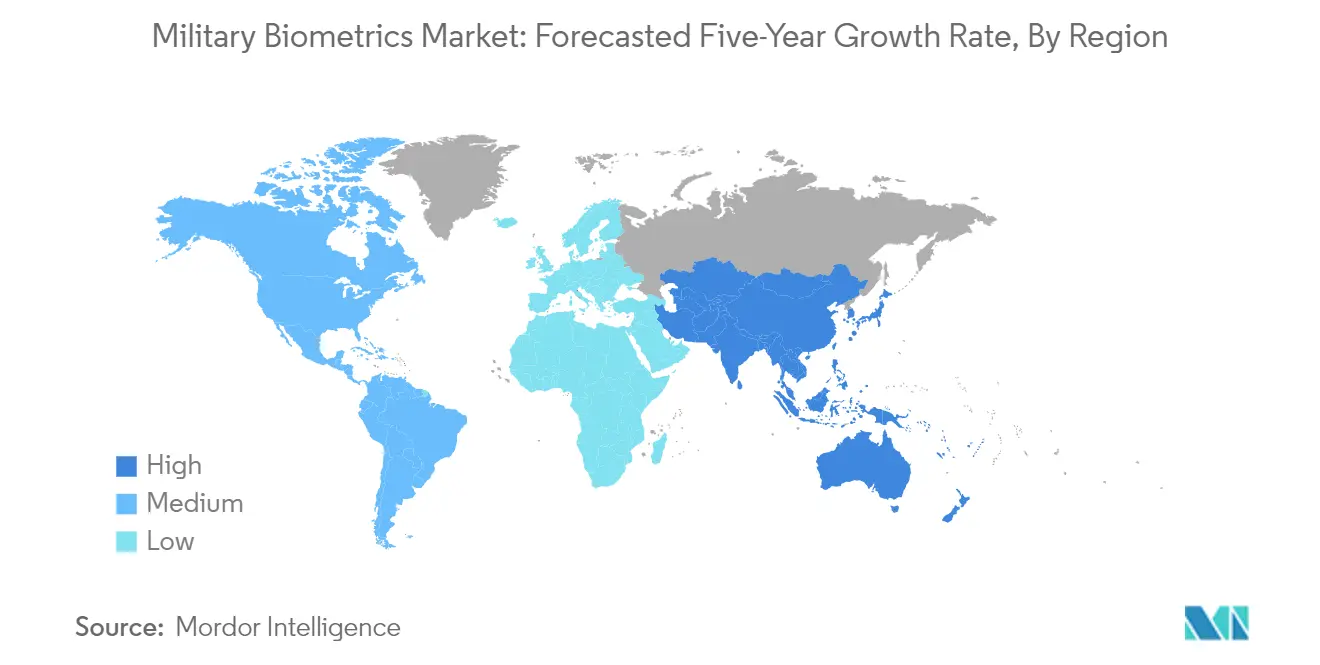Military Biometrics Market Analysis
The Military Biometrics Market size is estimated at USD 7.62 billion in 2025, and is expected to reach USD 10.34 billion by 2030, at a CAGR of 6.29% during the forecast period (2025-2030).
The military biometrics landscape is undergoing significant transformation amid escalating global security concerns and technological advancements. The United States maintains approximately 750 military bases across 80 countries as of 2024, highlighting the extensive infrastructure requiring sophisticated defense security systems. This widespread military presence has catalyzed the development of integrated biometric solutions that can operate seamlessly across different geographical locations and security protocols. The integration of artificial intelligence and machine learning with military biometrics systems has enhanced their capability to process and analyze data in real-time, leading to more accurate identification and threat detection capabilities.
The evolution of biometric technology has resulted in increasingly sophisticated systems capable of handling multiple authentication factors simultaneously. A prime example is the US government's IDENT system, which processes approximately 300,000 biometric transactions daily and maintains a repository of over 200 million identities. This demonstrates the massive scale at which modern military identification systems operate. The industry has witnessed significant advancements in facial recognition, fingerprint scanning, and iris recognition technologies, with newer systems incorporating multiple biometric markers for enhanced security verification.
Cloud computing integration has emerged as a transformative force in military biometrics applications, enabling more efficient data storage, processing, and sharing capabilities. The migration of the Department of Defense's Automated Biometrics Information System (ABIS) to the cloud in September 2023 marks a significant milestone in this evolution, enhancing global system availability and performance. This shift towards cloud-based solutions has facilitated better interoperability between different military branches and international allies, while also improving the speed and accuracy of biometric identification processes.
The industry is witnessing a strong focus on developing comprehensive security solutions that integrate various biometric modalities. For instance, Qatar's implementation of 15,000 cameras with facial recognition technology for the 2022 World Cup demonstrates the scale and sophistication of modern biometric security systems. Military organizations are increasingly adopting multi-modal biometric systems that combine different identification methods, such as fingerprint, facial recognition, and iris scanning, to create more robust and reliable security protocols. This trend towards integrated solutions reflects the growing complexity of security requirements and the need for more sophisticated identification and verification systems in military identification applications.
Military Biometrics Market Trends
Steady Growth in Annual Defense Expenditure
The continuous surge in global defense expenditure has emerged as a primary driver for the military biometrics market, with nations significantly increasing their military spending to enhance security capabilities. In 2023, the United States led global defense spending with USD 916 billion, followed by China at USD 296 billion and Russia at USD 109 billion, highlighting the substantial financial commitment towards military modernization. This escalation in defense budgets has directly influenced the adoption of advanced biometric technologies, as militaries worldwide seek to upgrade their military identification and security systems. For instance, in October 2023, the US Army took a significant leap in biometric capabilities by issuing the Army Biometric Program Directive, emphasizing comprehensive efforts to implement fingerprinting, facial recognition, and iris scans for enhanced security measures.
The increased defense spending has catalyzed numerous military programs focusing on technological advancement and security enhancement. In January 2024, Ingenious Research Solutions, collaborating with DRDO, successfully developed an advanced authentication system combining facial recognition with gait analysis. This innovation, known as Divya Drishti, represents a significant milestone in India's strategic AI roadmap for the military. Similarly, in September 2023, Leidos achieved a notable breakthrough by migrating the Department of Defense's Automated Biometrics Information System (ABIS) to the cloud, demonstrating how increased defense budgets are facilitating the modernization of military biometric infrastructure. These developments underscore how sustained defense expenditure is driving innovation and implementation of sophisticated biometric solutions across defense security systems.
Growing Investments to Counter Terrorism Activities
The escalating need to combat terrorism has prompted substantial investments in military biometric systems, with nations worldwide implementing cutting-edge identification and surveillance technologies. Advanced military facial recognition technology has become instrumental in military operations, offering unparalleled accuracy in identifying potential threats and securing military installations. For instance, in March 2024, Magal, a Rafael Advanced Defense Systems subsidiary, unveiled its integration of artificial intelligence (AI) tools into military base protection solutions, emphasizing enhanced data fusion and analysis capabilities through its proprietary software suite, Fortis X Command, Control, Communications, Computers, Cyber, and Intelligence (C5I).
The commitment to counter-terrorism through biometric solutions is evident in recent strategic initiatives across various nations. In August 2023, Qatar deployed an extensive network of 15,000 cameras equipped with facial recognition technology, demonstrating the scale of investment in biometric surveillance systems for security enhancement. Similarly, in October 2023, Mexico initiated the construction of a 20-story biometric surveillance hub along its border with the United States, featuring advanced surveillance systems connected across 13 cities in Mexico's northern region. This facility aims to streamline coordination between law enforcement and military units in combating criminal activities and potential terrorist threats. These implementations highlight how nations are leveraging biometric technologies as a crucial component of their counter-terrorism strategies, driving significant growth in the military biometrics market.
Segment Analysis: By Recognition Type
Fingerprint Recognition Segment in Military Biometrics Market
Fingerprint recognition technology continues to dominate the military biometrics market, commanding approximately 61% market share in 2024. This segment's prominence stems from its mature technology foundation, seamless integration capabilities, and superior cost-efficiency compared to other biometric solutions. Military organizations worldwide prefer fingerprint recognition systems for their proven reliability in military identification, access control to sensitive areas, and secure authentication processes. The technology's widespread adoption is further driven by its ability to process high volumes of identifications quickly and accurately, making it particularly valuable for large-scale military deployments and installations. Advanced fingerprint scanning devices now incorporate features like liveness detection and enhanced image capture quality, providing robust security measures against potential spoofing attempts while maintaining operational efficiency in various environmental conditions.
Iris Recognition Segment in Military Biometrics Market
The iris recognition segment is experiencing remarkable growth in the military biometrics market, with a projected growth rate of approximately 7% during 2024-2029. This acceleration is driven by the technology's unparalleled accuracy and reliability in identity verification, particularly crucial for high-security military applications. The non-invasive nature of iris scanning, combined with its ability to function effectively in various lighting conditions, makes it increasingly attractive for military installations and checkpoints. Recent technological advancements have enhanced the speed and precision of iris recognition systems, while also improving their resistance to spoofing attempts. The segment's growth is further supported by increasing investments in research and development, leading to more compact, mobile, and user-friendly iris scanning devices that can be deployed in diverse military scenarios, from base security to battlefield identification.
Remaining Segments in Military Biometrics Market
The military biometrics market encompasses other significant recognition types, including military facial recognition and various emerging technologies such as DNA recognition, finger geometry recognition, keystroke recognition, and signature recognition. Military facial recognition technology has gained substantial traction due to its non-contact nature and ability to perform mass surveillance in military installations. The technology's integration with artificial intelligence and machine learning has enhanced its accuracy and reliability in various lighting conditions and angles. Other recognition types, including DNA and behavioral biometrics, provide complementary security layers in military applications, offering unique advantages for specific use cases. These technologies are particularly valuable in multi-factor authentication systems, where different biometric modalities work together to provide enhanced security and reliability in military operations.
Military Biometrics Market Geography Segment Analysis
Military Biometrics Market in North America
North America stands as a pivotal region in the military biometrics market, driven by substantial defense investments and technological advancement initiatives. The United States and Canada form the core of this market, with both nations demonstrating a strong commitment to enhancing their military capabilities through biometric solutions. The region's leadership position is reinforced by the presence of major defense contractors, robust research and development infrastructure, and an increasing focus on national security measures. Both countries are actively implementing advanced military biometrics systems across military installations, border control points, and security checkpoints, while also investing in next-generation identification technologies.
Military Biometrics Market in United States
The United States dominates the North American military biometrics market, commanding approximately 97% of the regional market share in 2024. The country's military biometrics sector is characterized by extensive deployment across various defense applications, from access control at military bases to battlefield identification systems. The US military's adoption of biometric technologies spans multiple domains, including fingerprint recognition, facial recognition, and iris scanning systems. The Department of Defense continues to enhance its biometric capabilities through initiatives like the Automated Biometric Identification System (ABIS), while also investing in cloud-based solutions and artificial intelligence integration to improve identification accuracy and speed.
Military Biometrics Market in Canada
Canada emerges as the fastest-growing market in North America, with a projected growth rate of approximately 7% from 2024 to 2029. The country's military biometrics sector is experiencing rapid evolution, driven by increasing defense modernization initiatives and a growing emphasis on border security. The Canadian Armed Forces are actively incorporating advanced biometric solutions across their operations, particularly in areas of personnel identification and access control. The nation's focus on developing indigenous biometric capabilities, coupled with strategic partnerships with technology providers, positions it for sustained growth in the military biometrics market.
Military Biometrics Market in Europe
Europe represents a significant market for military biometrics, characterized by diverse adoption patterns across different countries. The United Kingdom, Germany, France, and Italy are the key markets driving regional growth, each contributing uniquely to the advancement of military biometric technologies. The region's market is shaped by increasing defense modernization programs, growing security concerns, and the need for enhanced military identification systems. European nations are collectively working towards standardizing biometric systems while maintaining robust security protocols across military installations.
Military Biometrics Market in United Kingdom
The United Kingdom leads the European military biometrics market, holding approximately 30% of the regional market share in 2024. The country's military sector demonstrates a strong commitment to biometric technology adoption, implementing advanced systems across various defense applications. British military installations worldwide utilize sophisticated biometric access control systems, while also investing in research and development of next-generation identification technologies. The UK's approach to military biometrics emphasizes both security enhancement and operational efficiency, with a particular focus on integrating biometric authentication into wearable devices for soldiers.
Military Biometrics Market in Germany
Germany showcases remarkable growth potential in the European military biometrics market, with a projected growth rate of approximately 5% from 2024 to 2029. The country's military sector is actively embracing biometric technologies, particularly in areas of personnel identification and access control at military facilities. German armed forces are implementing sophisticated biometric systems while maintaining strict data privacy and ethics standards. The nation's focus on developing advanced biometric solutions, coupled with increasing defense investments, positions it as a key growth market in the region.
Military Biometrics Market in Asia-Pacific
The Asia-Pacific region demonstrates robust development in the military biometrics market, with China, India, Japan, and South Korea leading the market evolution. These nations are actively investing in advanced biometric technologies to enhance their military capabilities and security infrastructure. The region's market is characterized by increasing defense modernization initiatives, growing security concerns, and rapid technological advancement in biometric systems. Countries across the region are focusing on developing indigenous capabilities while also engaging in international collaborations to strengthen their military identification infrastructure.
Military Biometrics Market in China
China emerges as the dominant force in the Asia-Pacific military biometrics market, leading the regional landscape with its comprehensive approach to biometric technology integration. The country's military sector demonstrates a strong commitment to advancing biometric capabilities, implementing sophisticated systems across various defense applications. Chinese military installations utilize advanced biometric access control systems, while also investing heavily in research and development of next-generation identification technologies. The nation's focus on indigenous development of biometric solutions, coupled with significant defense investments, reinforces its position as the regional market leader.
Military Biometrics Market in India
India stands out as the fastest-growing market in the Asia-Pacific region, demonstrating remarkable advancement in military biometric technology adoption. The country's armed forces are rapidly modernizing their biometric capabilities, implementing advanced systems across various military applications. India's focus on indigenous development of biometric solutions, coupled with increasing defense investments, drives market growth. The nation's commitment to enhancing its military identification systems, while also developing domestic technological capabilities, positions it as a key growth market in the region.
Military Biometrics Market in Latin America
Latin America's military biometrics market is experiencing steady growth, with Brazil and Mexico emerging as key players in the region. Brazil leads the regional market and demonstrates the highest growth potential, driven by its comprehensive approach to military modernization and security enhancement. The region's market development is characterized by increasing investments in border security, a growing emphasis on military personnel identification systems, and rising adoption of advanced biometric technologies. Countries in the region are actively implementing biometric solutions across military installations while also focusing on developing domestic capabilities to reduce dependence on foreign technologies.
Military Biometrics Market in Middle East & Africa
The Middle East & Africa region showcases significant potential in the military biometrics market, with Saudi Arabia, United Arab Emirates, and Qatar driving regional growth. The United Arab Emirates leads the regional market, while Saudi Arabia demonstrates the strongest growth trajectory. The region's market is characterized by substantial defense investments, an increasing focus on security enhancement, and growing adoption of advanced identification systems. Countries across the region are implementing sophisticated biometric solutions across military installations, while also investing in research and development to enhance their technological capabilities. The emphasis on modernizing military infrastructure and strengthening security measures continues to drive the adoption of biometric technologies across the region.
Military Biometrics Industry Overview
Top Companies in Military Biometrics Market
The military biometrics market features established players like Leidos Holdings, Thales, Northrop Grumman, and HID Global Corporation leading the innovation frontier. Companies are increasingly focusing on developing advanced recognition technologies, including multi-modal biometric solutions that combine fingerprint, facial, and iris recognition capabilities. Strategic partnerships with defense departments and research institutions are driving technological advancement, particularly in AI-enhanced biometric systems and cloud-based solutions. Market leaders are expanding their geographical presence through military base installations and cross-border collaborations, while simultaneously investing in portable and wearable biometric devices. The emphasis on research and development has led to breakthrough innovations in 3D facial recognition, blockchain integration for data security, and AI-driven authentication systems, positioning these companies at the forefront of military security solutions.
Consolidated Market with Strong Defense Ties
The military biometrics landscape is characterized by a mix of large defense conglomerates and specialized biometric technology providers, with major players maintaining strong relationships with defense departments globally. The market structure shows significant consolidation, particularly among top-tier providers who possess the necessary technological capabilities and security clearances for military applications. These established players have built their positions through decades of defense sector experience, substantial R&D investments, and strategic acquisitions of smaller, innovative biometric technology firms.
The market demonstrates high barriers to entry due to stringent military specifications, security requirements, and the need for extensive testing and certification processes. Merger and acquisition activities are primarily driven by large defense contractors acquiring specialized biometric technology companies to enhance their capabilities and maintain competitive advantages. This consolidation trend is further reinforced by the military's preference for working with proven, reliable suppliers who can provide comprehensive solutions and long-term support for critical defense security systems.
Innovation and Integration Drive Market Success
Success in the military biometrics market increasingly depends on companies' ability to integrate cutting-edge technologies while maintaining the highest security standards. Market leaders are focusing on developing comprehensive solutions that combine multiple biometric modalities, enhanced by artificial intelligence and cloud computing capabilities. Companies are also investing in research and development to create more robust, portable, and user-friendly systems that can operate effectively in diverse military environments. The ability to provide seamless integration with existing military infrastructure and demonstrate clear operational benefits has become crucial for maintaining and expanding market share.
For emerging players and contenders, the path to market success lies in identifying and exploiting specific technological niches while building strong partnerships with established defense contractors. Companies must navigate complex regulatory requirements, including data privacy laws and military security standards, while maintaining flexibility to adapt to evolving security threats. The future competitive landscape will favor those who can balance innovation with reliability, offering solutions that address the military's growing need for rapid, accurate, and secure identification systems while maintaining operational efficiency and cost-effectiveness.
Military Biometrics Market Leaders
-
IDEMIA
-
Northrop Grumman Corporation
-
THALES
-
Leidos Holding Inc.
-
HID Global Corporation
- *Disclaimer: Major Players sorted in no particular order
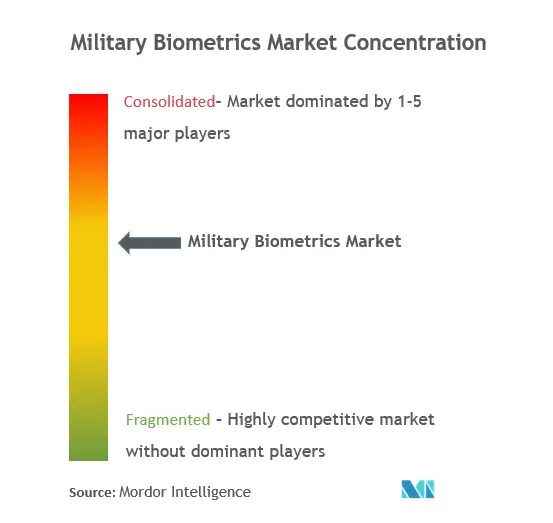
Military Biometrics Market News
May 2024: The Mauritius Government selected Thales' cutting-edge identity solution, cementing a decade-long partnership to propel the nation's digital transformation. Thales' solution streamlines citizens' enrollment and ensures a seamless issuance of physical and digital identities.
May 2024: Bahrain's Information & eGovernment Authority (iGA) inked a deal with THALES to modernize Bahrain's ID card infrastructure. The collaboration focuses explicitly on enhancing the cards' biometric features, showcasing a shared dedication to bolster Bahrain's digital landscape.
Military Biometrics Market Report - Table of Contents
1. INTRODUCTION
- 1.1 Study Assumptions
- 1.2 Scope of the Study
2. RESEARCH METHODOLOGY
3. EXECUTIVE SUMMARY
4. MARKET DYNAMICS
- 4.1 Market Overview
- 4.2 Market Drivers
- 4.3 Market Restraints
-
4.4 Porter's Five Forces Analysis
- 4.4.1 Bargaining Power of Suppliers
- 4.4.2 Bargaining Power of Buyers/Consumers
- 4.4.3 Threat of New Entrants
- 4.4.4 Threat of Substitute Products
- 4.4.5 Intensity of Competitive Rivalry
5. MARKET SEGMENTATION
-
5.1 Recognition Type
- 5.1.1 Fingerprint Recognition
- 5.1.2 Facial Recognition
- 5.1.3 Iris Recognition
- 5.1.4 Other Recognition Types
- 5.1.4.1 DNA Recognition
- 5.1.4.2 Finger Geometry Recognition
- 5.1.4.3 Keystroke Recognition
- 5.1.4.4 Signature Recognition
-
5.2 Geography
- 5.2.1 North America
- 5.2.1.1 United States
- 5.2.1.2 Canada
- 5.2.2 Europe
- 5.2.2.1 United Kingdom
- 5.2.2.2 Germany
- 5.2.2.3 France
- 5.2.2.4 Italy
- 5.2.2.5 Rest of Europe
- 5.2.3 Asia-Pacific
- 5.2.3.1 China
- 5.2.3.2 Japan
- 5.2.3.3 India
- 5.2.3.4 South Korea
- 5.2.3.5 Rest of Asia-Pacific
- 5.2.4 Latin America
- 5.2.4.1 Brazil
- 5.2.4.2 Mexico
- 5.2.4.3 Rest of Latin America
- 5.2.5 Middle East and Africa
- 5.2.5.1 Saudi Arabia
- 5.2.5.2 United Arab Emirates
- 5.2.5.3 Qatar
- 5.2.5.4 Rest of Middle East and Africa
6. COMPETITIVE LANDSCAPE
- 6.1 Vendor Market Share
-
6.2 Company Profiles
- 6.2.1 Iritech Inc.
- 6.2.2 M2SYS
- 6.2.3 IDEMIA
- 6.2.4 Aware Inc.
- 6.2.5 Fulcrum Biometrics Inc.
- 6.2.6 Northrop Grumman Corporation
- 6.2.7 Leidos Holdings Inc.
- 6.2.8 Corvus Integration Inc.
- 6.2.9 HID Global Corporation
- 6.2.10 NEC Corporation
- 6.2.11 BIO-key International Inc.
- 6.2.12 THALES
- *List Not Exhaustive
7. MARKET OPPORTUNITIES AND FUTURE TRENDS
Military Biometrics Industry Segmentation
Military biometrics refers to using biometric technologies in military operations, enhancing security, authentication, and identification processes. In this context, a biometric system, an electronic configuration, is employed to confirm an individual's identity. These systems, equipped with various hardware and software components, capture physical inputs, analyze them, and grant authentication. Biometrics entails measuring and statistically analyzing an individual's physical and behavioral characteristics. Biometric identification safeguards entry, data, or access by leveraging human biological markers such as DNA or fingerprints.
The military biometrics market is segmented by recognition type and geography. By recognition type, the market is segmented into fingerprint recognition, facial recognition, iris recognition, and other recognition types. The other types include DNA recognition, finger geometry recognition, keystroke recognition, and signature recognition. The report also covers the market sizes and forecasts for the military biometrics market in major countries across different regions. For each segment, the market size is provided in terms of value (USD).
| Recognition Type | Fingerprint Recognition | ||
| Facial Recognition | |||
| Iris Recognition | |||
| Other Recognition Types | DNA Recognition | ||
| Finger Geometry Recognition | |||
| Keystroke Recognition | |||
| Signature Recognition | |||
| Geography | North America | United States | |
| Canada | |||
| Europe | United Kingdom | ||
| Germany | |||
| France | |||
| Italy | |||
| Rest of Europe | |||
| Asia-Pacific | China | ||
| Japan | |||
| India | |||
| South Korea | |||
| Rest of Asia-Pacific | |||
| Latin America | Brazil | ||
| Mexico | |||
| Rest of Latin America | |||
| Middle East and Africa | Saudi Arabia | ||
| United Arab Emirates | |||
| Qatar | |||
| Rest of Middle East and Africa | |||
Military Biometrics Market Research FAQs
How big is the Military Biometrics Market?
The Military Biometrics Market size is expected to reach USD 7.62 billion in 2025 and grow at a CAGR of 6.29% to reach USD 10.34 billion by 2030.
What is the current Military Biometrics Market size?
In 2025, the Military Biometrics Market size is expected to reach USD 7.62 billion.
Who are the key players in Military Biometrics Market?
IDEMIA, Northrop Grumman Corporation, THALES, Leidos Holding Inc. and HID Global Corporation are the major companies operating in the Military Biometrics Market.
Which is the fastest growing region in Military Biometrics Market?
Asia Pacific is estimated to grow at the highest CAGR over the forecast period (2025-2030).
Which region has the biggest share in Military Biometrics Market?
In 2025, the North America accounts for the largest market share in Military Biometrics Market.
What years does this Military Biometrics Market cover, and what was the market size in 2024?
In 2024, the Military Biometrics Market size was estimated at USD 7.14 billion. The report covers the Military Biometrics Market historical market size for years: 2019, 2020, 2021, 2022, 2023 and 2024. The report also forecasts the Military Biometrics Market size for years: 2025, 2026, 2027, 2028, 2029 and 2030.
Our Best Selling Reports
Military Biometrics Market Research
Mordor Intelligence offers a comprehensive analysis of the military biometrics industry, drawing on our extensive experience in defense technology research. Our latest report explores the evolving landscape of military identification systems and defense security systems. It provides detailed insights into market dynamics, technological innovations, and growth opportunities. The analysis covers various applications, such as military facial recognition technologies and advanced authentication solutions. This information is available in an easy-to-read report PDF format for immediate download.
This detailed examination of the military biometrics market offers stakeholders crucial intelligence for strategic decision-making. The report provides an in-depth analysis of emerging technologies, regulatory frameworks, and regional adoption patterns across different military sectors. Our research helps industry participants understand implementation challenges, identify growth opportunities, and optimize their strategic positioning in this rapidly evolving sector. The comprehensive coverage includes detailed case studies, competitive analysis, and future market projections. It is an essential tool for organizations involved in military security and defense technology implementation.

